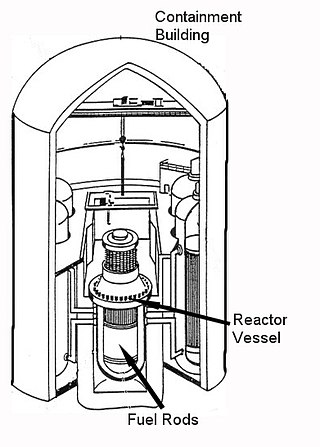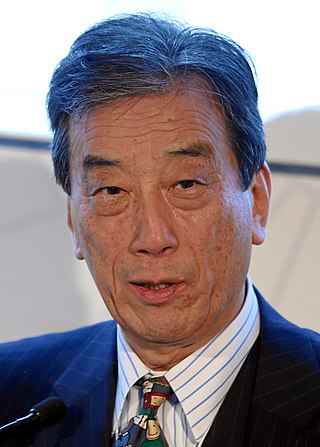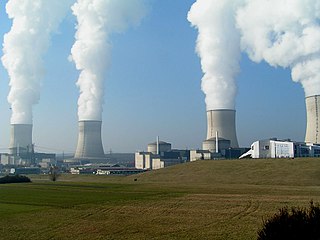Related Research Articles

A nuclear meltdown is a severe nuclear reactor accident that results in core damage from overheating. The term nuclear meltdown is not officially defined by the International Atomic Energy Agency or by the United States Nuclear Regulatory Commission. It has been defined to mean the accidental melting of the core of a nuclear reactor, however, and is in common usage a reference to the core's either complete or partial collapse.

The Nuclear Regulatory Commission (NRC) is an independent agency of the United States government tasked with protecting public health and safety related to nuclear energy. Established by the Energy Reorganization Act of 1974, the NRC began operations on January 19, 1975, as one of two successor agencies to the United States Atomic Energy Commission. Its functions include overseeing reactor safety and security, administering reactor licensing and renewal, licensing radioactive materials, radionuclide safety, and managing the storage, security, recycling, and disposal of spent fuel.

A nuclear and radiation accident is defined by the International Atomic Energy Agency (IAEA) as "an event that has led to significant consequences to people, the environment or the facility. Examples include lethal effects to individuals, large radioactivity release to the environment, reactor core melt." The prime example of a "major nuclear accident" is one in which a reactor core is damaged and significant amounts of radioactive isotopes are released, such as in the Chernobyl disaster in 1986 and Fukushima nuclear disaster in 2011.

The International Nuclear and Radiological Event Scale (INES) was introduced in 1990 by the International Atomic Energy Agency (IAEA) in order to enable prompt communication of safety significant information in case of nuclear accidents.

A containment building is a reinforced steel, concrete or lead structure enclosing a nuclear reactor. It is designed, in any emergency, to contain the escape of radioactive steam or gas to a maximum pressure in the range of 275 to 550 kPa. The containment is the fourth and final barrier to radioactive release, the first being the fuel ceramic itself, the second being the metal fuel cladding tubes, the third being the reactor vessel and coolant system.

Prior to the 2011 Tōhoku earthquake and tsunami, Japan had generated 30% of its electrical power from nuclear reactors and planned to increase that share to 40%. Nuclear power energy was a national strategic priority in Japan. As of March 2020, of the 54 nuclear reactors in Japan, there were 42 operable reactors but only 9 reactors in 5 power plants were actually operating. A total of 24 reactors are scheduled for decommissioning or are in the process of being decommissioned. Others are in the process of being reactivated, or are undergoing modifications aimed to improve resiliency against natural disasters; Japan's 2030 energy goals posit that at least 33 will be reactivated by a later date.

Nuclear safety is defined by the International Atomic Energy Agency (IAEA) as "The achievement of proper operating conditions, prevention of accidents or mitigation of accident consequences, resulting in protection of workers, the public and the environment from undue radiation hazards". The IAEA defines nuclear security as "The prevention and detection of and response to, theft, sabotage, unauthorized access, illegal transfer or other malicious acts involving nuclear materials, other radioactive substances or their associated facilities".

Nuclear safety in the United States is governed by federal regulations issued by the Nuclear Regulatory Commission (NRC). The NRC regulates all nuclear plants and materials in the United States except for nuclear plants and materials controlled by the U.S. government, as well those powering naval vessels.

The Onagawa Nuclear Power Plant genshiryoku hatsudensho, Onagawa NPP) is a nuclear power plant located on a 1,730,000 m2 site in Onagawa in the Oshika District and Ishinomaki city, Miyagi Prefecture, Japan. It is managed by the Tohoku Electric Power Company. It was the most quickly constructed nuclear power plant in the world.

The Fukushima Daiichi Nuclear Power Plant is a disabled nuclear power plant located on a 3.5-square-kilometre (860-acre) site in the towns of Ōkuma and Futaba in Fukushima Prefecture, Japan. The plant suffered major damage from the magnitude 9.1 earthquake and tsunami that hit Japan on March 11, 2011. The chain of events caused radiation leaks and permanently damaged several of its reactors, making them impossible to restart. The working reactors were not restarted after the events.

The Fukushima nuclear accident was a major nuclear accident at the Fukushima Daiichi nuclear power plant in Ōkuma, Fukushima, Japan which began on March 11, 2011. The proximate cause of the accident was the 2011 Tōhoku earthquake and tsunami, which resulted in electrical grid failure and damaged nearly all of the power plant's backup energy sources. The subsequent inability to sufficiently cool reactors after shutdown compromised containment and resulted in the release of radioactive contaminants into the surrounding environment. The accident was rated seven on the INES by NISA, following a report by the JNES.
The Investigation Committee on the Accident at the Fukushima Nuclear Power Stations of Tokyo Electric Power Company was formed June 7, 2011 by the Japanese government as an independent body to investigate the March Fukushima Daiichi nuclear disaster. The Investigation Committee issued an interim report in December 2011, and issued its final report in July 2012.

National Diet of Japan Fukushima Nuclear Accident Independent Investigation Commission or NAIIC is the commission to investigate the background and cause of Fukushima Daiichi nuclear disaster formed by the statutory law enactment by Diet of Japan on 7 October 2011 and started with the first commissioning meeting was held in Fukushima City, Fukushima Prefecture. The commission is scheduled to issue the report in six months on investigation and to propose the policy to reduce and prevent future accident and reduce damage on the nuclear power plant in Japan.

The Fukushima Daiichi nuclear accident genshiryoku hatsudensho jiko) was a series of equipment failures, nuclear meltdowns, and releases of radioactive materials at the Fukushima I Nuclear Power Plant, following the Tōhoku earthquake and tsunami on 11 March 2011. It was the largest nuclear disaster since the Chernobyl disaster of 1986, and the radiation released exceeded official safety guidelines. Despite this, there were no deaths caused by acute radiation syndrome. Given the uncertain health effects of low-dose radiation, cancer deaths cannot be ruled out. However, studies by the World Health Organization and Tokyo University have shown that no discernible increase in the rate of cancer deaths is expected. Predicted future cancer deaths due to accumulated radiation exposures in the population living near Fukushima have ranged in the academic literature from none to hundreds.

Investigations into the Fukushima Daiichi Nuclear Disaster (or Accident) began on 11 March 2011 when a series of equipment failures, core melt and down, and releases of radioactive materials occurred at the Fukushima Daiichi Nuclear Power Station from the 2011 off the Pacific coast of Tohoku Earthquake and tsunami on the same day.

The Fukushima Daiichi nuclear disaster genshiryoku hatsudensho jiko) was a series of equipment failures, nuclear meltdowns, and releases of radioactive materials at the Fukushima I Nuclear Power Plant, following the Tōhoku earthquake and tsunami on 11 March 2011. It is the largest nuclear disaster since the Chernobyl disaster of 1986.

Nuclear power plants pose high risk if chemicals are exposed to those in surrounding communities and areas. This nuclear emergency level classificationresponse system was firstly developed by the US Nuclear Regulatory Commission to allow effective and urgent responses to ultimately control and minimise any detrimental effects that nuclear chemicals can have. These classifications come in four different categories – Unusual Event, Alert, Site Area Emergency (SAE), as well as General Emergency. Thus, each classification has differing characteristics and purposes, depending on the situation at hand. Every nuclear power plant has a different emergency response action plan, also depending on its structure, location and nature. They were developed by thorough discussion and planning with numerous authoritative parties such as local, state, federal agencies as well as other private and non-profit groups that are in association with emergency services. Today, nuclear emergency plans are continuously being developed over time to be improved for future serious events to keep communities and nuclear power plant working members safe. There is a high emphasis for the need of these emergency responses in case of future events. Thus, nuclear plants can, and have paid up to approximately $78 million to ensure that are required measurements are readily available, and that equipment is sufficient and safe. This is applicable for all nuclear power plants in the United States of America.
References
- ↑ "NRC: Glossary -- Design-basis accident". United States Nuclear Regulatory Commission. Retrieved 7 February 2017.
- ↑ "Design basis accident". European Nuclear Society . Retrieved 7 February 2017.
- ↑ "An Exceptional Nuclear Glossary". nuclearglossary.com. Archived from the original on 7 September 2017. Retrieved 7 February 2017.
- ↑ "NRC: Glossary -- Beyond design-basis accidents" . Retrieved 7 February 2017.
- ↑ Acton, James M.; Hibbs, Mark (March 2012). "Why Fukushima Was Preventable" (PDF). Carnegie Endowment for International Peace .
- ↑ Ungethuem, J.; Stokes, M. D. "Overview of Beyond-design Basis Accident Management with Particular Reference to Severe Accident Scenarios in German Pressurized Water Reactors" (PDF). Paul Scherrer Institut. Archived from the original (PDF) on 26 August 2011. Retrieved 7 February 2017.
- ↑ Rogovin, Mitchell (1980). Three Mile Island: A Report to the Commissioners and to the Public (PDF). Vol. 1. Washington, D.C.: United States Nuclear Regulatory Commission. p. 3. Retrieved 17 October 2021.
Long before the accident at Three Mile Island, there was a high bravado quotient widespread throughout the industry and its regulators. Licensing procedures were not entirely adequate, giving rise to deficiencies in some plant designs. Operator training was totally inadequate for emergencies, and poorly monitored. Control rooms were often designed with precious little attention to the operators' needs. The lessons learned from malfunctions and mistakes at nuclear plants both here and abroad were never effectively shared within the industry.
- ↑ Todreas, Neil E. (1992). Nuclear Systems: Elements of Thermal Hydraulic Design. Vol. 2. CRC Press. p. 347.
- ↑ Fackler, Martin (1 June 2011). "Report Finds Japan Underestimated Tsunami Danger". The New York Times . Retrieved 18 August 2019.
- ↑ Declan Butler (21 April 2011). "Reactors, residents and risk". Nature. 472 (7344): 400–401. doi:10.1038/472400a. PMID 21525903. S2CID 4371109.